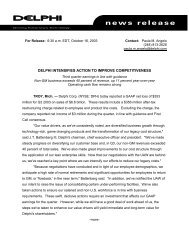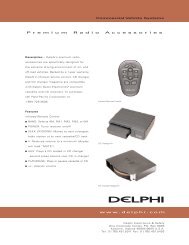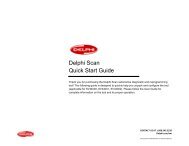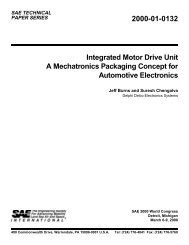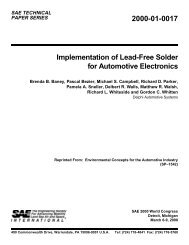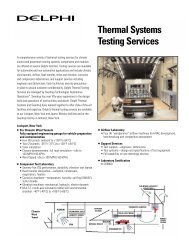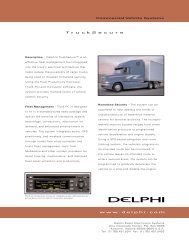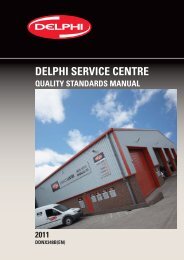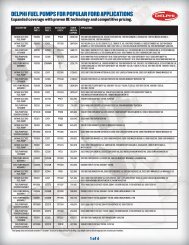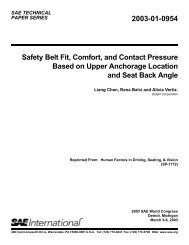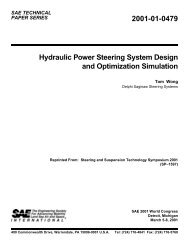2001-01-0595 A Model-Based Brake Pressure Estimation ... - Delphi
2001-01-0595 A Model-Based Brake Pressure Estimation ... - Delphi
2001-01-0595 A Model-Based Brake Pressure Estimation ... - Delphi
You also want an ePaper? Increase the reach of your titles
YUMPU automatically turns print PDFs into web optimized ePapers that Google loves.
orifice with flow area a 1 , and enters the caliper’s chamber<br />
to build up pressure P c so as to move the brake pad. At<br />
the same time, the release valve is closed. When the<br />
control command is in “RELEASE” mode, the fluid from<br />
the caliper chamber flows through the release valve’s<br />
orifice with flow area a 2 , and goes back to the tank. In<br />
this mode, the apply valve is closed. A third state is the<br />
“HOLD” mode, which is when both apply and release<br />
valves are closed. The brake pad is modeled by a mass,<br />
spring and damper system.<br />
<strong>Pressure</strong> Relief Valve<br />
M<br />
P s<br />
a 1<br />
Apply<br />
command<br />
Q 1<br />
Release<br />
command<br />
Q 2<br />
a 2<br />
V 0<br />
P c<br />
Caliper<br />
Piston x p<br />
Figure 1 <strong>Model</strong> schematic of one simplified channel<br />
hydraulic-mechanical schematic of the brake pressure<br />
control system<br />
To summarize, the symbols used in Figure 1 are defined<br />
as follows:<br />
P s hydraulic line pressure<br />
P c caliper chamber pressure<br />
x p caliper piston displacement<br />
V o initial chamber volume<br />
Q 1 flow rate from apply valve<br />
Q 2 flow rate from release valve<br />
a 1 orifice area for apply valve<br />
a 2 orifice area for release valve<br />
K p<br />
B p<br />
a p caliper piston area<br />
M p mass of the piston<br />
B p damping coefficient<br />
K p effective spring constant<br />
MATHAMATICAL MODEL<br />
From Figure 1, the mathematical model of TCS brake<br />
pressure control system is described by the following<br />
equations [3][4].<br />
M ⋅ x + B ⋅ x + K ⋅ x = P ⋅ a − F<br />
(1)<br />
p<br />
⋅⋅<br />
p<br />
Q −Q<br />
p<br />
⋅<br />
p<br />
V<br />
+<br />
p<br />
p<br />
+ V<br />
β<br />
c<br />
dPc<br />
⋅<br />
dt<br />
⋅<br />
c o<br />
1 2 = a p ⋅ xp<br />
(2)<br />
V a ⋅ x<br />
c<br />
Q<br />
Q<br />
1<br />
= (3)<br />
p<br />
p<br />
2 ⋅(<br />
Ps<br />
− Pc<br />
)<br />
= Cd<br />
⋅ a1<br />
⋅<br />
(4)<br />
ρ<br />
= C<br />
⋅ a<br />
⋅<br />
2⋅<br />
Pc<br />
ρ<br />
2 d 2<br />
(5)<br />
where ρ is the fluid density, C d is the orifice flow<br />
discharge coefficient, β is fluid bulk modulus, V c is the<br />
feeding chamber volume, and F ko is the spring preload.<br />
MODEL SIMPIFICATION<br />
Assuming that the brake pressure is calculated only when<br />
the brake pad is in full contact with the brake disc. Then,<br />
⋅⋅<br />
x ≈ 0 , ≈ 0<br />
p<br />
⋅<br />
x . The fluid compliance effect is also<br />
p<br />
assumed negligible for the small volume V c , that is,<br />
V<br />
c<br />
+<br />
β<br />
V<br />
o<br />
≈ 0<br />
simplified to<br />
K x = P ⋅ a − F<br />
p<br />
p<br />
c<br />
. Equations (1) and (2) are therefore,<br />
⋅ (6)<br />
p<br />
ko<br />
p<br />
ko



